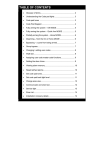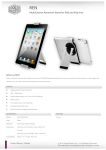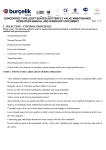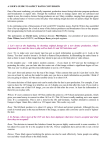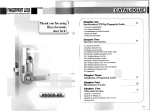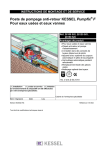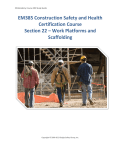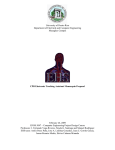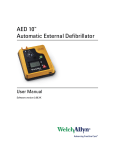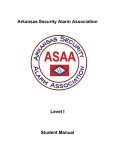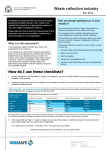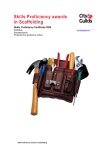Download Safety Procedures Manual - DuPage Habitat for Humanity
Transcript
SAFETY PROCEDURES MANUAL Revision 1.1 January 3, 2011 THE PURPOSE OF THIS DOCUMENT The safety goal of DuPage Habitat is to have an accident free environment. To accomplish this goal, DuPage Habitat has a safety program that defines roles and responsibilities, procedures and training of staff and volunteers participating in Build Day activities. The purpose of this document is to describe the DuPage Habitat safety program and how it is implemented. REVISION CONTROL The document owner for this procedures manual is the Construction Manager, a staff position. This person has responsibility for approving this document and releasing subsequent revisions when changes are required. Document Owner: Construction Manager Revision 1.1 Revision 1.0 January 3, 2011 December 24, 2010 Amended for new daily schedule First Release TABLE OF CONTENTS page SAFETY GOAL ………………………………………………………………………….... 1 WHO HAS RESPONSIBILITY FOR SAFETY? (adapted from DHFH Safety Policy) ....…. 1 Construction Manager, Construction Leadership Team, Safety Leader, House Leaders, and Crew Leaders IMPLEMENTING SAFETY – PROCEDURES (adapted from Build Day Best Practices) ......…. 2 Who is responsible for implementing safety best practices? Certification of Crew Leaders How do House Leaders and Crew Leaders receive safety training? What do you do when you see an unsafe practice? When are safety best practices taught to Visiting Volunteers? The Safety Check List – posted at construction site The Site Information Sheet – posted at construction site Who can be counted on for CPR and first aid? What happens after an accident? Safety documents, first-aid kits, fire-extinguishers, and safety equipment on site TRAINING MODULES (from the Habitat for Humanity Affiliate Insurance Program online training) …. 9 Training modules required for Crew Leader certification (modules 1-5) Additional training modules for construction participants (modules 6-14) Training modules for DHFH leadership (modules 15-19) How to access training modules online SAFETY BEST PRACTICES …………………………………………..………..……….. 10 General checklist items Personal Protective Equipment Power tool safe operation Ladder safety Scaffolding Roof safety Guarding wall openings Guarding floor openings Eliminate slip and trip hazards Fire extinguishers Working in hot conditions - precautions ANNUAL SAFETY PROGRAM ………………………………………………………….. 13 CONFIRMATION THAT THE PROCESS IS IMPLEMENTED ……………………... 13 APPENDIX A: SAFETY POLICY (Board of Director approved November 1, 2010) …………….. 14 APPENDIX B: TRAINING MODULES ………………………………….……………….. (overview of each online training module from the Habitat for Humanity Affiliate Insurance Program) 16 APPENDIX C: SAFETY CHECKLISTS BY CONSTRUCTION TASK ……………….. 25 (one example shown with 14 others under development) SAFETY GOAL The safety goal of DuPage Habitat is to have an accident free environment. To achieve this goal, the affiliate will have a safety program that defines roles and responsibilities, procedures and training of staff and volunteers participating in Build Day activities. DuPage Habitat will follow the procedures and requirements set forth in this document which borrows heavily from Habitat for Humanity International’s Affiliate Operations Manual: Construction (2009), Chapter 2. The AOM sets out a listing of safety procedures and protocols. Additionally, appropriate OSHA requirements will also be met. As a point of clarification, this document describes the safety program. Also required is an annual safety program which describes specific actions in the business plan to assure that the safety program is implemented effectively. See page 13 for details. WHO HAS RESPONSIBILITY FOR SAFETY? The responsibility for conducting work in a safe manner rests with every individual participating in construction activities. DuPage Habitat will implement a program of safety training to maximize the chance that all individuals are operating in a safe manner and utilizing appropriate safety equipment. The following leadership positions have special responsibilities with respect to safety implementation: Construction Manager: The Construction Manager has overall responsibility for safety at DuPage Habitat. The Construction Manager will rely on the Construction Committee to develop and implement the safety program and will provide support as required. The Construction Manager assures that proper safety equipment is present at all active work sites. The Construction Manager must confirm that construction tasks will be performed utilizing the proper safety equipment. The Construction Manager has the direct responsibility for assuring that subcontractors are in compliance with DuPage Habitat risk management procedures. This includes but is not limited to: • • • • • Subcontractors sign the Subcontractor Agreement provided by the affiliate. Subcontractors are in compliance with all contractual obligations by providing required proof of insurance and certification. Assuring that subcontractors notify the Construction Manager if conditions exist that they feel are unsafe and may prevent them from completing work. Assuring that subcontractors leave the site without hazards for the next Build Day. Assuring that subcontractors notify the Construction Manager of any injury or accident that occurs during the execution of their contract responsibilities. 1 Construction Leadership Team: The Construction Leadership Team consists of between 4 and 8 members and includes the Construction Manager and the Construction Committee Chair(s). The Construction Leadership Team is responsible for approving the annual safety program for DuPage Habitat. The safety program includes the development of safety documents, procedures and best practices as well as training implementation. Safety Leader: The Safety Leader develops an annual safety program which is approved by the Construction Leadership Team. The annual safety program should be submitted as part of the Construction Committee’s annual business plan. The Safety Leader will report to the Construction Manager on the implementation of the safety program. In the absence of having someone fill the position of Safety Leader, the Construction Manager will assume all responsibilities of the Safety Leader. House Leaders: House Leaders have overall safety responsibility for the construction site during Build Day. They will be trained in first aid and CPR. Specific safety training for House Leaders is specified in this document on page 7. Crew Leaders: Crew Leaders have hands-on safety responsibility at the construction site particularly when working with teams of Visiting Volunteers. They will be trained in first aid and CPR. Specific safety training for Crew Leaders is specified in this document on page 7. IMPLEMENTING SAFETY - PROCEDURES The goal for DHFH and HFHI is to have zero accidents. This recognizes that all accidents are avoidable if proper diligence is given to implementing good safety practices. It also recognizes that there needs to be continuous improvement of the affiliate’s knowledge base of safety best practices. Who is responsible for implementing safety best practices? Everyone at the build site has a role in assuring that safety best practices are implemented. However, the House Leader has overall responsibility to assure the site is safe and safety best practices are implemented. Crew Leaders have the responsibility to teach safety best practices to the volunteers that make up their teams. Certification of Crew Leaders DuPage Habitat makes a commitment to train Crew Leaders to work effectively during Build Days. This is an investment in them and the success of the organization. The following are the requirements for Crew Leader certification: • • • • • • Complete Crew Leader training (on CD and based on Build Day Best Practices) Complete CPR and first aid training (scheduled by DHFH as classes) Work on site three times as a Crew Leader and approval by House Leader Complete the 5 core safety modules (offered Tuesday evenings or online) Complete 3 construction task training classes (offered Tuesday evenings) Final approval by the Construction Manager 2 How do House Leaders and Crew Leaders receive safety training? Habitat for Humanity International and Lockton Affinity have teamed up to create the Habitat for Humanity Affiliate Insurance Program. Within this program, is an online course of safety training modules for volunteers. There are 66 modules in the program, of which 19 are recommended for DuPage Habitat as specified on page 7 of this document. Appropriate safety training modules should be taken online or attended when they are presented during Tuesday evening planning meetings. If a module is taken online, DuPage Habitat should receive notification of completion for their records from the volunteer. What do you do when you see an unsafe practice? DuPage Habitat wants everyone to use safe practices, especially those they learn in the safety training. One step further, DuPage Habitat has zero tolerance for doing tasks in an unsafe manner. But what should you do if you see someone else doing something in an unsafe manner? You need to address it promptly. If you are comfortable talking to the person involved, you can tell them that there is a safer way to do the task and take it upon yourself to show them. This is the preferred response. If you are not comfortable engaging the person doing an unsafe task, you need to inform the House Leader immediately so they can resolve the situation quickly before an accident occurs. An individual who does tasks in an unsafe manner will be shown the safe and correct way to proceed. If the House Leader finds that this individual repeatedly does work in an unsafe manner, DuPage Habitat may send them a written notice asking them to comply with our safety procedures. If the unsafe behavior persists, the individual will be given written notice that they are not to participate at the build site. Certainly, we hope the situation does not go this far. In summary, when you see someone doing a task in an unsafe manner, you must address it immediately. When are safety best practices taught to Visiting Volunteers? Prior to showing up at the build site, Visiting Volunteers are given a number of orientation documents by email. One of these documents is the Volunteer Safety flyer which is shown in Figure 1. At the discretion of the Construction Manager, this flyer may be posted at the construction site. 3 Volunteer Safety Safety is our first priority, and should be yours too! Please work in a responsible and safe manner at all times. Ask your Crew Leader if you do not know how to complete a task or use a piece of equipment. When lifting heavy materials, lift with your legs not with your back. When carrying long materials, be aware of your surroundings. Watch your footing for nails, electrical cords, and other hazards. Remove nails from discarded lumber. Use protective equipment (hard hats, gloves, safety glasses) and do not abuse or misuse materials or equipment. Do not use power tools if you have not been trained to use them or if you are under 18. Report all accidents, injuries, or unsafe conditions to a House Leader. All injuries must be documented with the House Leader. House and Crew Leaders are trained in CPR and first aid. The first aid kit and a list of local hospitals are located at the break area. In the case of an emergency or serious injury, CALL 911 and alert a Crew Leader or House Leader. NO SMOKING on the construction site. Please step to the curb. Clean up as you go. Return tools and equipment to their proper places when not in use. Crew Leaders will go over more safety topics specific to your task. Figure 1. The Volunteer Safety flyer given to Visiting Volunteers by email. Visiting Volunteers will also receive a verbal safety talk from the House Leader during the volunteer orientation speech at the beginning of Build Day. The House Leader’s safety talk should highlight bullet points on the Safety Check List that are specific to the construction tasks that will be performed during that day. 4 The Safety Check List The Safety Check List captures most of the safety practices encountered at a DuPage Habitat construction site. It is shown in Figure 2. It must be posted at the construction site in a location near the center of construction activity. Safety Check List SAFETY RULES FOR VOLUNTEER WORKERS: 1. Report to your Crew Leader (or House Leader) any condition that looks unsafe. 2. Wear a hard hat when someone is working above you. * 3. Wear ear plugs in high noise areas. * 4. Wear safety glasses with side shields when operating power saws or other equipment that throw off small hard particles. * 5. Make sure blade guards are in place when operating power saws. 6. Use a respirator or face mask when working in dusty atmospheres. * 7. Wear leather gloves when handling wood and metal products. * 8. Avoid stepping on electrical power cords, especially in wet locations. * 9. Keep electrical power cords off the ground as much as possible. 10. Make sure that a ground fault circuit interrupter (GFCI) is in place before plugging in electrical power cords. 11. Do not use broken or malfunctioning tools, especially those with electrical problems. 12. Do not use ladders as work platforms; use scaffolding instead. * 13. Do not use aluminum ladders around electrical power lines. * 14. Make sure that guardrails and toe boards are in place when working on scaffolding platforms more than 10 feet high. * 15. If you cut yourself, report to your Crew Leader (or House Leader) immediately for first aid. 16. If someone else cuts him/herself and blood gets on you, report this immediately to your Crew Leader (or House Leader). 17. DuPage Habitat for Humanity will have identified if asbestos is present at a rehab site. Follow their instructions and avoid touching, handling or disturbing it. If it needs to be handled, it will be handled by specialists. 18. DuPage Habitat for Humanity will have identified if lead based point is present. Follow their instructions and make sure you wash hands before eating. * DuPage Habitat for Humanity will supply the equipment and supplies to handle these situations. Figure 2. This standardized Safety Check List which must be posted. 5 The Site Information Sheet DuPage Habitat for Humanity safety policy requires that site information be posted at the construction site in a location near the center of construction activity. It must be pointed out during the volunteer orientation. Figure 3 shows a filled out example of a Site Information Sheet from 2008. Blanks for this excel spreadsheet are available on the Construction section of SharePoint. SITE INFORMATION SHEET Address: 4923 N Lincoln, Westmont, IL Police: (630) 968-2152 Fire Department: (630) 829-4480 Nearest Hospital: Advocate Good Samaritan Hospital (630) 275-4085 4924 Forest Ave., Downers Grove, IL Directions to Hospital: Start at 4923 N LINCOLN going west toward W 40TH ST – go 0.05 mi Turn Right on W OGDEN AVE (US 34) – go 1.7 mi Turn Left on MAIN ST – go 0.7 mi Turn Right on FRANKLIN ST Turn left on FOREST AVE Arrive at 4923 FOREST AVE, DOWNERS GROVE on Right House Leader: Dennis Harvey Construction Manager: Brian Harris (847) 682-6911 BUILD DAY SCHEDULE Latest Arrival Time: 7:45 AM Start Time: 8:00 AM Morning Break: 10:30-10:45 AM Lunch: 12:00 – 12:30 PM Clean-up & Feedback: 3:00 – 3:30 PM End of Day: 3:30 PM Figure 3. An example of a Site Information Sheet which must be posted. 6 The Site Information Sheet must include the following information: • • • • Emergency information o Address of construction site o Telephone number of Police o Telephone number of Fire Department o Address of nearest Hospital o Directions to nearest Hospital (a map is preferred) Name of House Leader Name of Construction Manager and cell phone number Build Day Schedule o Arrive at 7:45 A.M. o 8:00 A.M. start o Morning Break (one common time or have Crew Leaders decide) o 12:00 – 12:30 P.M. lunch time o 3:00 - 3:30 P.M. clean-up and fill out feedback form o 3:30 P.M. end of day The Site Information Sheet should be posted in such a way as to enable a 911 caller to have access to directions for an ambulance while remaining with an accident victim. Again, it must be posted at the construction site in a location near the center of construction activity. Who can be counted on for CPR and first aid? It is Habitat for Humanity International policy that all House Leaders and Crew Leaders be trained in CPR and first aid. DuPage Habitat arranges for this training on an as needed basis. Since everyone may not be current in this training, it is prudent for the House Leader to confirm who on his/her team can be counted on if such an emergency arises. What happens after an accident? If an accident occurs, an Accident Claim Form must be filled out by the House Leader as soon as practical. This form is required by the Chubb Group of Insurance Companies which insure DuPage Habitat. The forms must be available on site and are also available on Sharepoint for downloading. Note that the form requires the signature of the volunteer who was injured. Accident situations need to be discussed at the Tuesday evening planning meeting so the situation and subsequent improvements to safety practices can be passed on other DuPage Habitat sites. Safety documents, first-aid kits, fire extinguishers, and safety equipment on site In all cases, it is the responsibility of the House Leader to make sure the equipment specified in this section is present on site, complete and in good working order. 7 Safety Documents: Best practice is to have a file box of forms at each build site. The forms should include: • • • Waivers (adult and teenagers – which will require sign-off by an adult) Accident Claim Forms Extra copies of the Safety Check List, Site information Sheet, Safety Procedures Manual, Build Day Best Practices – User’s Manual, Volunteer Feedback forms, Volunteer Check-In Sheets, and Home Construction Specification. First-Aid Kits: A first-aid kit must be present on site. DuPage Habitat will standardize these kits so they are the same at every build site. This makes it easier for Regular Volunteers to find needed items when an emergency arises. The kit must be at the construction site in a location near the center of construction activity. Each kit must have the following documentation: • • • A label that identifies the contents of the kit. Heartsaver First Aid Quick Reference Guide. Enclose hard copies of the Site Information Sheet for use by first responders. Each kit should include the following medical items: ITEM Size Quantity Absorbent compress Adhesive bandage (Band-aid®) Adhesive tape Antibiotic treatment packets Antiseptic swab Antiseptic wipe Antiseptic towelette Bandage compress (2 in.) Bandage compress (3 in.) Bandage compress (4 in.) Burn dressing Burn treatment packet CPR barrier Cold pack (4 x 5 in.) Eye covering with means of attachment Eye wash Gloves * Roller bandage (2 in.) Roller bandage (4 in.) Sterile pad Triangular bandage 32 sq in. 1 x 3 in. 5 yd. 1/32 oz. 0.14 fluid oz. 1 x 1 in. 24 sq. in. 2 x 36 in. 3 x 60 in. 4 x 72 in. 4 x 4 in. 1/32 oz. 1 16 2 6 10 10 10 4 2 1 1 6 1 1 2 4 2 pair 1 1 2 4 4 x 5 in. 2.9 sq. in. 1 fluid oz. Medium 2 in. x 6 yd. 4 in. x 6 yd 3 x 3 in. 40 x 40 x 56 in * Gloves must be latex or equivalent. Note that some people are allergic to latex so an alternative is preferred if available. 8 Fire Extinguishers: A fire extinguisher should be on site and located in the same vicinity as the first aid kit where it is immediately accessible (a location near the center of construction activity). The fire extinguisher should be a 10 pound dry chemical rated for ABC. This is a general purpose fire extinguisher and suitable for most fires likely to be encountered at a DuPage Habitat work site. It is important to note that once a dry chemical fire extinguisher is partially discharged, it cannot be used again until refilled professionally. The dry chemical prevents the pressure seal from seating and all pressure will be lost in a short time. Safety Equipment: Safety equipment should be in adequate supply to cover the needs of Build Day. It is the responsibility of the House Leader to make sure an adequate supply is requested of the Construction Manager in time for delivery before Build Days. The safety equipment that should be on hand includes: • Safety goggles with side shields (clean) • Ear plugs (hearing protection) • Gloves (an assortment to cover the needs of the construction tasks of the day) • Hard hats (enough for all volunteers on the work site) TRAINING MODULES Habitat for Humanity International and Lockton Affinity have teamed up to create the Habitat for Humanity Affiliate Insurance Program. Within this program, is an online course of safety training modules for volunteers. Appropriate safety training modules should be taken online or attended when presented during Tuesday evening planning meetings. If a module is taken online, DuPage Habitat should receive notification of completion for their records from the volunteer. Of the 66 modules available, 19 are recommended for DuPage Habitat participants. The content of each module is given in Appendix A. The numbering system that appears in this manual is for the purposes of DuPage Habitat and is not used online. However, the titles that appear here are identical to those online. For planning purposes, the time for each module is also given. Training modules required for Crew Leader certification The following 5 core safety modules are required for Crew Leader certification and recommended for House Leaders and Regular Volunteers working at DuPage Habitat. They can be taken at the Tuesday evening meetings or online. If taken online, see the section further down for instructions. 1 – Volunteering On a Habitat for Humanity Job Site 2 – Emergency Action and Fire Prevention 3 – Fall Safety 4 – Portable Power Tool Safety 5 – Slips, Trips and Falls 9 Additional training modules for construction participants The following modules are recommended for House Leaders, Crew Leaders, and Regular Volunteers working at DuPage Habitat. They should be scheduled into the mix of training during the Tuesday evening meetings, particularly when they are relevant to construction tasks that are coming up soon after the meeting. 6 – Working in Hot Conditions 7 – Electrical Safety – Unqualified Worker 8 – Ergonomics – Industrial 9 – Eye Protection 10 – Flammable and Combustable Liquids 11 – Good Housekeeping 12 – Hand Protection 13 – Mold Hazards and Prevention 14 – Noise and Hearing Protection Training modules for DuPage Habitat leadership The following training modules are recommended for DuPage Habitat staff involved in construction and the Construction Committee Leadership Team 15 – You Are Exposed – General Affiliate Safety 16 – Workplace Safety for Employees 17 – Hazard Communication 18 – Defensive Driving – Commercial Vehicles 19 – PPE – Hazard Assessment and Selection How to access training modules online To access these modules online follow the steps below. • Go to http://www.hfhvolunteerinsurance.com • Click on “Take Volunteer Course Now” • Enter Employee Access Code: W8NAEBTG There is a prompt to get a certificate of completion when you are finished with the module and have taken the quiz at the end. This requires an identification number. At this time, DuPage Habitat has not implemented this procedure. Once a volunteer has taken a training module, they should notify the Construction Manager that they have done so. Their name will be logged into the DuPage Habitat database. SAFETY BEST PRACTICES The following checklist is for safety best practices that are most common at construction sites for DuPage Habitat. The checklist is derived from the training modules. For a more in depth understanding of each area, see Appendix B. Personal Protective Equipment • Shoes must provide some protection from objects falling on the foot - no open toed shoes are allowed on site. 10 • • • • • • • Hard hats must be worn when work is being done overhead or when material may not be permanently secured overhead (DHFH supplies) Goggles with side shields must be worn when using power tools that cut, drill or nail (DHFH supplies) Work gloves should be used to protect against slivers and yard work abrasion (DHFH supplies) Ear protection should be used when using high noise power tools such as circular saws (DHFH supplies) Dress appropriately for the weather conditions No smoking on site – step to the curb if necessary Know your PPE and use it when it’s supposed to be used Power tool safe operation • • • • • • • • • • • • Never carry a tool or unplug it by the cord or hose Disconnect tools when they are not in use Make sure observers are at a safe distance Secure work with a vise, clamp, or other support Keep cords and hoses away from heat, liquids, and sharp edges Examine tools before each use Keep cutting tools sharp and lubricated Do not wear loose clothes, ties, or jewelry Tie back long hair Mark or tag all damaged tools with a “Do Not Use” Wear safety glasses for power tools that cut or nail Use fire curtains near flammables Ladder Safety • • • • • • • • • • • Inspect for damage before use. Ladder should be clean and free of debris Face the ladder when climbing Maintain 3 points of contact with the ladder at all times Stand no higher than the third tread Ladders used for access to higher areas must extend three feet beyond the access point Stable left-right and top-bottom Do not place a ladder on top of another item Use Ladder Stabilizers to prevent ladder sway Do not use a step ladder as an extension ladder 4:1 Rule – Place a ladder out from the wall 1 foot for every 4 feet of rise Scaffolding • • All scaffolds must be inspected daily by a competent person before use Base plate of lags must be on solid ground or mudsills (Be careful of soil changes after rain) 11 • • • • • Guardrails and mid rails are required on sides and end panels of each working level Toe boards are required to help prevent tools and materials from being kicked off Full planking must be placed on all work levels. Scaffold grade planking must be used and be free of structural defects Tie-ins or bracing are required for stability Safe access to the scaffolding is required Roof Safety • • • • • • • • Do not work on roofs with excessive pitch (can be subcontracted) For ladder access, ladder must extend 3 feet above entry point Wear proper footwear to provide traction and avoid wet conditions Avoid excessive winds Keep roof clear of debris Use tie-offs when appropriate Employ roof brackets when appropriate Use fall arrest systems when appropriate Guard floor openings • • Floor coverings – frame the area and cover it with a clearly marked cover Guardrails must be used around larger openings that can’t be covered o Top rail placed 42 inches from floor o Mid rail placed at 21 inches from floor o Toe boards in place when work is being performed below o Guardrail must withstand a 200 lb. load Guarding wall openings • • • • Wall openings must be guarded just like a floor opening Place a top rail at 42 inches from the floor Railing must withstand 200 lb load Install a second guardrail if ladder work is being performed in the area Eliminate slip and trip hazards • • • • • • • • Minimize power cords, ropes, and hoses across floors Eliminate clutter in walkways Clean up liquids Sweep up debris and dust Stop and repair leaks Install absorbent around wet situations Use warning signs or cones Wear slip-resistant shoes Fire Extinguishers • • Fire extinguishers must be within 100 feet of the construction site To use the fire extinguisher: 12 o o o o Pull the pin Aim at the base of the fire Squeeze the trigger Sweep back and forth Working in hot conditions - precautions • • • • • Schedule heavy work for a cooler time of day Allow more frequent breaks or longer rest periods Drink plenty of water Drink electrolyte-balanced fluids if you sweat a lot Avoid caffeine and alcohol ANNUAL SAFETY PROGRAM The DuPage Habitat safety program is specified in this document. The annual safety program describes specific actions in the business plan needed to assure that the safety program is implemented effectively. The annual safety program is defined by the Safety Leader and approved by the Construction Leadership Team for inclusion with the annual business plan for the Construction Committee. The annual safety program should include the following: • • • • A schedule of when safety modules will be presented at the Tuesday evening planning meeting How and when on-site safety audits will be conducted Plan to review and update (if needed) any safety documents Any other safety initiatives that are appropriate CONFIRMING THAT THE PROCESS IS IMPLEMENTED The Construction Manager has the responsibility to assure that the safety process, procedures and annual program are implemented properly. At the time of the release of this Safety Procedures Manual, the Construction Manager will develop a summary report for House Leaders to fill out after each Build Day to confirm safety compliance and to identify any specific issues that may need to be recorded or addressed. This summary report may include the following: • • • • Regular Volunteers or Crew Leaders who did not comply with safety procedures Regular Volunteers or Crew Leaders who arrived late Safety equipment which was needed but not available or usable Any safety related incidents The Construction Manager will also do spot checks at build sites to further confirm that safety procedures and best practices are implemented. More formal audits may be specified in the Construction Committee’s annual business plan. 13 APPENDIX A - SAFETY POLICY 1.0 (approved by the Board of Directors Nov 1, 2010) Purpose To set the basic requirements for the safety program and practices for Dupage Habitat for Humanity. 2.0 Safety Goal The safety goal of DuPage Habitat is to have an accident free environment. To achieve this goal, the affiliate will have a safety program that defines roles and responsibilities, procedures and training of volunteers participating in Build Day activities. DuPage Habitat will follow the procedures and requirements set forth in Chapter 2 of the Affiliate Operations Manual: Construction (2009), which sets out a complete listing of safety procedures and protocols. Additionally, appropriate OSHA requirements will also be met. 3.0 Responsibilities The responsibility for conducting work in a safe manner rests with every individual. DuPage Habitat will implement a program of training and safety awareness to maximize the chance that all individuals involved in Build Day activities are operating in a safe manner with appropriate safety equipment. The following leadership positions have special responsibilities with respect to safety: 3.1 Construction Leadership Team The Construction Leadership Team consists of between 6 and 8 members and includes the Construction Manager and the Construction Committee Chair. The Construction Leadership Team is responsible for approving the annual safety program for DuPage Habitat. The safety program includes the development of safety documents, procedures and best practices as well as training materials and how they will be implemented. 3.2 Safety Leader The Safety Leader develops an annual program which is approved by the Construction Leadership Team. The annual safety program should be submitted as part of the Construction Committee’s annual business plan. The Safety Leader will report to the Construction Manager on the implementation of the safety program. In the absence of having someone fill the position of Safety Leader, the Construction Manager will assume all responsibilities of the Safety Leader. 3.3 Construction Manager The Construction Manager has overall responsibility for safety at DuPage Habitat. The Construction Manager will rely on the Construction Committee to develop and implement the safety program and will provide support as required. The Construction Manager assures that proper safety equipment is present at all active work sites. The Construction Manager must confirm that no construction tasks will be performed without utilizing the proper safety equipment. Subcontractors: The Construction Manager has the direct responsibility for assuring that subcontractors are in compliance with DuPage Habitat safety and risk management procedures. This includes but is not limited to: • • • • • Subcontractors sign the Subcontractor Agreement provided by the affiliate. Subcontractors are in compliance with all contractual obligations by providing required proof of insurance and certification. Assuring that subcontractors notify the Construction Manager if conditions exist that they feel are unsafe and may prevent them from completing work. Assuring that subcontractors leave the site without hazards for the next Build Day. Assuring that subcontractors notify the Construction Manager of any injury or accident that occurs during the execution of their contract responsibilities. 14 3.4 House Leaders House Leaders have overall safety responsibility at build sites during Build Days. Specifically, they are responsible for the following safety related points: • • • • • 3.4 Asssure adherance to relevant safety requirements specified in DuPage Habitat Safety Manual as well as relevant OSHA requirements. Asssure that DuPage Habitat approved safety information is posted on site and reviewed with Visiting Volunteer groups at the beginning of Build Days. Specify any safety equipment necessary for Build Day to the Construction Manager with enough lead time to assure it is on site when needed. Be trained in CPR and first aid as required by Habitat for Humanity International. Complete investigation and accident reports if a safety incident occurs. Crew Leaders Crew Leaders have direct contact with Visiting Volunteers and therefore have front-line responsibility that their crews are conducting build activities in a safe manner. Specifically, Crew Leaders have the following safety responsibilities: • • • 4.0 Teach and coach Visiting Volunteers on safe practices and the use of safety equipment. Have completed basic safety training provided by DuPage Habitat in order to be certified as a Crew Leader. Be trained in CPR and first aid as required by Habitat for Humanity International. Safety Training DuPage Habitat will create basic safety training for all House Leaders and Crew Leaders as part of their certification as House Leaders and Crew Leaders. The Safety Leader will assure the training is implemented and the Construction Committee will track completion of this training. The Safety Leader will also schedule and assure CPR and first aid training is available. The Construction Committee will track completion of CPR and first aid training for all House Leaders and Crew Leaders. The Safety Leader will identify additional safety training modules for Crew Leaders and House Leaders that will be required for them to be certified as experts in specific construction tasks (for example: scaffold safety for siding certification). The Construction Committee will track completion of these additional safety modules before a House Leader or Crew Leader is certified as an expert. Prior to participating in a Build Day, Visiting Volunteers will be given a safety overview flyer by the Volunteer Coordinator. The Safety Leader is responsible for maintaining this document which will be under revision control. The Safety Leader is responsible for assuring that all safety information that is posted at build sites is current. Posted information will be under revision control to assure standardization. 5.0 Safety Documentation DuPage Habitat for Humanity will maintain certain documents pertaining to safety which will be under revision control. The Safety Leader will be responsible for making sure these documents are current, while the Construction Leadership Team approves new revisions. These documents include: • • • • • • • DuPage Habitat Safety Maunal (which details the safety procedures for the affiliate). The safety flyer issued to Visiting Volunteers prior to their participation in Build Days. The Safety Check List which is posted at all build sites. The format of the Site Information Sheet which is posted at all build sites. The basic safety training module for all House Leaders and Crew Leaders. Any form used to confirm that safety precedures were appropriately covered during Build Day. The documentation method used to log completion of safety modules by House Leaders and Crew Leaders. 15 APPENDIX B: TRAINING MODULES These online modules are from the Habitat for Humanity Affiliate Insurance Program. For instructions on how to access these modules on the Internet, refer to page 8 of this manual. 1 - Volunteering On A Habitat for Humanity Job Site (17:20 minutes) This module will be recommended for visiting volunteers to view prior to arriving at a build site. It includes selected slides from other modules and does not cover any new material. House Leaders and Crew Leaders should know what Visiting Volunteers have learned from this module. These are the “must have” expectations for conducting build activities in a safe manner. 2 – Emergency Action and Fire Protection (20:25 minutes) This module covers the following: • Hazards that lead to an emergency o Fuels – flammable and combustible liquids o Ignition sources – overheated equipment, open flames o Electrical fire hazards o Flammable chemical hazards – spill hazards o Natural disasters (i.e. tornadoes) or workplace violence • Evacuation of an area in an emergency • Response to an emergency o Emergency response information (posted DHFH Info Sheet) o Medical response (CPR and First Aid training of HLs and CLs) • Preventing fires – Housekeeping o Keep your work area clean and organized o Keep dusts away from motors and hot machinery o Dispose of oily or solvent-soaked rags appropriately o Don’t let combustible materials accumulate o Keep exits clear o Maintain access to fire response equipment • Responding to spills o Evacuate the area o Notify a supervisor o Remove ignition sources if safe to do so • Respond to fires o Remove yourself from danger o Notify others: trigger the alarm o Retrieve a fire extinguisher o Call for additional help o If fighting a fire, continuously evaluate for the necessity of evacuation o Don’t fight structural fires yourself • Types of fire extinguishers o A – For combustibles such as trash, wood, or paper o B – For flammable liquids or gasses o C – For electrical fires o D – For combustible metals • Using a fire extinguisher o Pull the pin o Aim at the base of the fire o Squeeze the trigger o Sweep back and forth 16 3 – Fall Safety (18:23 minutes) This module starts with a review of statistics on the cost of falls. In 2006 and 2007, there were 835 deaths from ladder and roof accidents. Since 2001, Habitat for Humanity has paid out more than $10 million in fall claims. Also discussed were the consequences of falls: physical, social (including economic to the victim), and psychological. The following specific bullet items were taken directly from the module screens: Ladder Safety • Inspect for damage before use. • Ladder should be clean and free of debris • Face the ladder when climbing • Maintain 3 points of contact with the ladder at all times • Stand no higher than the third tread • Ladders used for access to higher areas must extend three feet beyond the access point • Stable left-right and top-bottom • Do not place a ladder on top of another item • Use Ladder Stabilizers to prevent ladder sway • Do not use a step ladder as an extension ladder • 4:1 Rule – Place a ladder out from the wall 1 foot for every 4 feet of rise Roof Safety • Do not work on roofs with excessive pitch (can be subcontracted) • For ladder access, ladder must extend 3 feet above entry point • Wear proper footwear to provide traction and avoid wet conditions • Avoid excessive winds • Keep roof clear of debris • Use tie-offs when appropriate • Employ roof brackets when appropriate • Use fall arrest systems when appropriate Guard floor openings • Guardrails o Top rail placed 42 inches from floor o Mid rail placed at 21 inches from floor o Toe boards in place when work is being performed below o Guardrail must withstand a 200 lb. load • Floor coverings – frame the area and cover it with a clearly marked cover Guarding wall openings • Wall openings must be guarded just like a floor opening • Place a top rail at 42 inches from the floor • Railing must withstand 200 lb load • Install a second guardrail if ladder work is being performed in the area Scaffolding • Learn the OSHA requirements for using scaffolds at www.osha.gov • All scaffolds must be inspected daily by a competent person before use • Base plate of lags must be on solid ground or mudsills (Be careful of soil changes after rain) • Guardrails and mid rails are required on sides and end panels of each working level • Toe boards are required to help prevent tools and materials from being kicked off • Full planking must be placed on all work levels. Scaffold grade planking must be used and be free of structural defects • Tie-ins or bracing are required for stability • Safe access to the scaffolding is required 17 4 – Portable Power Tool Safety (15:38 minutes) This module is one of the more important to view for all staff and volunteers since it has general applicability to work at DHFH. The outline below has been detailed enough to present somewhat of a checklist for use on site. The module contains the following information: • Portable power tool hazards o Hit by flying debris o Hit by broken tool parts o Puncture with a sharp tool o Explosion or fire when sparks from a tool ignite flammable or combustible materials (including high concentrations of dust) o Electric chock from a frayed or defective power cord o Musculoskeletal disorder (MSDs) from repetitive misuse of a tool • General precautions for operating power tools o Never carry a tool or unplug it by the cord or hose o Disconnect tools when they are not in use o Make sure observers are at a safe distance o Secure work with a vise, clamp, or other support o Keep cords and hoses away from heat, liquids, and sharp edges o Examine tools before each use o Keep cutting tools sharp and lubricated o Do not wear loose clothes, ties, or jewelry o Tie back long hair o Mark or tag all damaged tools with a “Do Not Use” o Always wear personal protective equipment (PPE) appropriate to the work o Use fire curtains near flammables • Use guards o Never operate a tool without its guard in place o Use the guard supplied by the tool manufacturer o Never remove or disable guards o Report any missing, broken, or disabled guards • Electric Tool Safety o Operate tools within their design limitations o Wear appropriate gloves and footwear o Store tools in a dry location o Do not use them in wet or damp locations o Work areas should be well lighted • Pneumatic Tool Safety (particularly nail guns) o Always wear eye and hearing protection o Make sure air hose connections are secure o Ensure the safety clip for attachments is installed and secure o Use screens to protect nearby workers o Never point the tool at anyone 5 – Slips, Trips and Falls (22:19 minutes) • Eliminate trip hazards (minimize power cords, ropes, and hoses across floors) • Open-sided floors and platforms o All floors and platforms 4 feet above ground must be guarded o Standard guard rails are required o Toe boards protect workers and equipment below • Eliminate clutter in walkways 18 • Secure floor and wall holes and openings o Hole measures 1 to 12 inches wide o Openings are greater than 12 inches wide o Guard with standard railings (high railing at 42”, mid railing at 21”) o Cover the hole or opening if possible (nail in place so it doesn’t slide) • Secure open pits, tanks, vats, and ditches • Ladder and stair safety (see Fall Safety Module for same detail) • Eliminate slip hazards o Clean up liquids o Sweep up debris and dust o Stop and repair leaks o Install absorbent around wet situations o Use warning signs or cones • Wear slip-resistant shoes 6 – Working in Hot Conditions (23:06 minutes) DuPage Habitat has experienced numerous days during the summer where the temperatures was oppressively hot. This module outlines the biology of hot conditions on the body and what precautions to take to minimize the potential of harm. • Understand how hot conditions affect your body o High temperature + high humidity + physical work = heat illness o Individual sensitivity to heat (acclimation, age, physical condition and overall health, metabolism, and use of alcohol) • Recognizing symptoms of heat illness o Sweat won’t evaporate o Heat rash o Fainting: prevent by moving around a little rather than standing still all the time o Heat cramps: caused by loss of salt when sweating (drink electrolyte liquids) o Heat exhaustion: feeling weak, dizzy, or nauseous (drink electrolyte liquids) o Heatstroke: Victim stops sweating Symptoms include hot, dry skin Confusion, convulsions, or loss of consciousness may follow Call for an ambulance immediately Keep victim cool and provide fluids if conscious • Precautions to reduce the risk of heat illness o Schedule heavy work for a cooler time of day o Allow more frequent breaks or longer rest periods o Drink plenty of water o Drink electrolyte-balanced fluids if you sweat a lot o Avoid caffeine and alcohol 7 – Electrical Safety – Unqualified Workers (25:07 minutes) Electrical work at DuPage Habitat is subcontracted to licensed electricians. DuPage Habitat volunteers are never to touch or modify electrical work. Even though DHFH volunteers do not do electrical work, electrical wiring and equipment is often in a non-finished state and thus presents a hazard potential. This module talks about such hazards as well as others that are within the scope of work conducted by volunteers. This module covers: • Understand the hazards of electricity 19 o o o o Considerable discussion about electrical damage to the body Relationship to amperage to injury Arc flash and arc blast Electrical burns and first aid • Identify and avoid common electrical hazards o Contact with power lines o Contact with damaged electrical equipment o Improper wiring o Overloading o Unsafe work practices • Follow safe work practices around electrical equipment o Work on electrical equipment only if qualified (such as setting up extension cords before home wiring is complete) o Illuminate work area o Use nonconductive ladders o Do not wear conductive apparel o Do not use conductive liquids (including water) near electricity o Do not defeat electrical interlocks 8 – Ergonomics – Industrial (25:55 minutes) DuPage Habitat does not have an ergonomics program which is mentioned in the module. However, the insight taught in this module is helpful in at least helping all volunteers to recognize when an activity has the potential to cause a musculoskeletal disorder (MSD). In many cases, forethought on task set-up and use of material handling aids can go a long way to minimizing the chance for injury. • Understand the principles of ergonomics o o o Develop safe work practices to reduce repetitive reaching, forceful exertions, bending and lifting, or working with vibrating equipment. 1.8 million MSD cases reported per year, 600,000 cause loss of work. Covered in OSHA General Duty Clause • Recognize the risk factors, signs, and symptoms of musculoskeletal disorders (MSDs) • Understand our program for identifying, reporting, and controlling MSDs o o o o o o Repetitive motions Forceful exertions (awkward positions, excessive weight, arms raised) Awkward postures Contact stress (pressure points) Vibrations Using tools not ergonomically designed • Know how to protect yourself from MSD injuries and reduce your risk o o o o o Change positions often; take stretch breaks Maintain neutral posture whenever possible Eliminate or reduce risk factors Use material-handling aids Report MSD symptoms 9 – Eye Protection (15:43 minutes) At DuPage Habitat, we require anyone who is working with power tools to wear goggles with side shields. These tools include drills and saws because of their tendency to produce flying objects and dust. Goggles with side shields should also be used when working with drywall and insulation. This is particularly hazardous when volunteers are looking upwards. 20 DuPage Habitat maintains a stock of goggles at each worksite. These can be used over prescription glasses. House Leaders must make sure there is an adequate supply of goggles prior to Build Days. The training module covers the following topics: • Identify potential eye hazards o Flying objects (chips, dirt, masonry work, fragments) Use goggles with side shields o Dust hazards (wood dust, foam dust, soot) Use goggles with tight side shields o Chemical hazards (splash, spray or mist causing burning) Use goggles or face shield for severe exposure o Heat hazards (steam, hot liquids, or open heat source) Use goggles, screen or reflective face shield o Sunlight hazards (retinal burn working outside) Use sunglasses and hat • Prevent eye injuries with protective eyewear o Sunglasses and prescription glasses usually do not meet standard (ANSI Z87.1) • Use, maintain, and inspect proper protective eyewear • Use appropriate first aid for emergencies o Eyewash station: Chemical splashes require immediate first aid with flush for 15 minutes 10 – Flammable and Combustible Liquids (21:53 minutes) DuPage Habitat tries to minimize the use of flammable and combustible liquids. However, there are some that are used and this module discusses procedures to safely store, dispense, and handle these liquids. • Examples of combustible liquids: isopropyl alcohol, propane, solvents (acetone, MEK, paint thinner, varnish), fuels such as gasoline, aerosol cans, oils, kerosene, greases, lubricants, and oil-based paints. • Discussion of spills and vapor concentrations • Discussion of ignition sources • Labeling and information contained on Material Safety Data Sheets: MSDS • Safe storage: o Specially designed flammable lockers o Keep away from ignition sources, sunlight, oxidizers • Safety procedures for containers, transferring liquids, special PPE 11 – Good Housekeeping (18:50 minutes) This module captures a number of issues addressed in other modules in more detail. Good housekeeping is called out in Build Day Best Practices –User’s Manual as an important activity for the benefit of safety, operating efficiency, and visibility to Visiting Volunteers. This module reinforces the benefit to safety. 12 – Hand Protection (29:38 minutes) DuPage Habitat maintains a stock of gloves at each worksite. House Leaders must make sure there is an adequate supply of gloves prior to Build Days. The training module covers the following topics: • Identify hand hazards o Skin absorption of harmful substances o Severe cuts, abrasions, or lacerations 21 o o Pinches, crushes, and punctures Cold and frostbite • Choosing the appropriate gloves for work tasks o Chemical resistant gloves o Cut, abrasion, and puncture resistant gloves o Disposable gloves • Know the limitations of hand protection o Do not use fabric gloves with liquids o Keep hands out of a machine’s danger zone o Do not wear gloves around machinery with moving parts • Use and take care of protective equipment (throw out when worn out) 13 – Mold Hazards and Prevention (28:02 minutes) This module should be taken by all House Leaders or Crew Leaders. It is particularly relevant to those who work on homes that undergo deconstruction (rehab). The module covers: • Understanding the potential health hazards of exposure to mold o Particular attention to people with compromised immune systems o Some people have allergies to molds o Fungal infections are particularly troublesome • Detecting mold and knowing where to look for it (needs moisture and a food source) o Flooding o Roof or plumbing leaks o Bathroom showers o Over humidification o Poor maintenance of humidification units o Damp basements o Steam from cooking o Condensation • Preventing mold from growing o Control moisture o Clean: wash and dry surfaces and dry or discard damp materials o Fix leaks o Design out contributing factors to mold formation • Cleanup small amounts of mold contamination safely but let professionals tackle larger contaminations. o Cleanup requires bleach o Larger amounts need to be done professionally with technicians using proper PPE. Construction Manager needs to be consulted if in doubt. 14 – Noise and Hearing Protection (19:59 minutes) The most common source of noise at DuPage Habitat construction sites is due to power tool usage; particularly rotary saws and cutting tools. Hearing protection should be used under these circumstances. This noise situation is aggravated if the sawing is done indoors where the sound may resonate. DHFH maintains ear protection for those using or in the vicinity of usage. House Leaders must make sure the supply of ear protection is adequately stocked. The module contains the following information. Note in slide 19 where there is an example of a 25 year old carpenter who has suffered hearing loss to the level of a 50 year old man. • Understand the effects of noise on hearing (review of dBA levels and OSHA Noise Exposure Limits) • Identify sources of noise in your workplace 22 • Describe the purpose of audiometric testing and be able to interpret your test results • Select, fit and use hearing protection 15 - You Are Exposed – General Affiliate Safety (17:34 minutes) This module is on risk management and is a must read for all leadership team members. The focus is on identifying exposures to risk and includes not only construction but also A Brush With Kindness, deconstruction, certain fundraising events, and ReStore. Highly emphasized is fall protection, cuts from power tools, and dropped tools. Coverage of insurance in special circumstances is also presented. 16 – Workplace Safety for Employees (28:36 minutes) This module is relevant to DHFH management staff for setting up an appropriate safety program for staff and participating volunteers. • Importance of workplace safety o Required by law to provide a safe workplace o Promotes productivity and morale (across entire organization) • Facts about OSHA and its mission o Created by Occupational Safety and Health Act of 1970 o Authority to oversee compliance with safety and health laws o Develops and enforces safety standards o Establishes rights and responsibilities of employers and employees • Legal and policy requirements • How you can contribute to workplace safety and health o Good housekeeping contributes to elimination of hazards (see module on Good Housekeeping for more details) o Personal Protective Equipment must be available for staff/volunteers (see module on PPE – Hazard Assessment and Selection for more details) o Electrical safety is pervasive issue in all of operations (see module on Electrical Safety – Unqualified Worker for more details) o Back safety: proper lifting techniques, availability and use of appropriate material handling equipment is required o Ergonomics: (see module on Ergonomics – Industrial for more details) o Hazard communication: Proper labeling, MSDSs, and medical attention required if exposed (see module on Hazard Communication for more details) o Machine safety: use of guarding and correct PPE (see module on Portable Power Tool Safety for more details) o Office safety: ergonomics, flammable liquids away from heat sources, drawers closed, housekeeping • Key safety concerns and precautions to prevent accidents and injuries o Emergency situations: (see module on Emergency Action and Fire Prevention for more details) o First aid and CPR (all construction staff, House Leaders and Crew Leaders must have first aid and CPR training) o Security precautions o Workplace violence: recognize signs of potential violence and take threats seriously, have a plan thought out beforehand o Terrorism: protect your computer, follow procedures for such an incident 23 17 – Hazard Communication (25:33 minutes) DuPage Habitat must design activities to minimize the use of hazardous materials including cleaning products. This module should be viewed by DHFH staff (Construction Manager and ReStore Manager). Subsequently, they may recommend that the module be viewed by volunteers if there are operations that put them at risk. The module covers the following key points: • • • • • • Identification of physical and chemical hazards Reading labels and MSDSs Following warnings and instructions, or ask your supervisor if in doubt Use the correct PPE Practice sensible, safe work habits Learn emergency procedures 18 – Defensive Driving – Commercial Vehicles (30:47 minutes) This module should be reviewed by drivers of DHFH trucks. following topics: • • • • • The scope of the module covers the Recognize driving hazards and dangerous conditions Avoid potential accidents Inspect and maintain your vehicle Operate your vehicle safely Respond to emergencies and accidents It is expected that DHFH will prepare a checklist of requirements for the operation of its truck(s). These requirements can be posted in this document at a later time. 19 – PPE – Hazard Assessment and Selection (25:44 minutes) This module details a systematic approach for leadership to evaluate recurring jobs to ensure that safety risks are present, what safety procedures should be in place, and what personal protective equipment (PPE) should be used. Specifically, the module covers the following topic areas: • • • • Conduct a hazard assessment to ensure all parts of the body are protected Conduct and certify the assessment for each job Select the appropriate PPE for the hazard(s) identified Train employees (volunteers) how to wear and care for PPE 24 APPENDIX C: SAFETY CHECKLISTS BY CONSTRUCTION TASK This is an example of one checklist for use at DuPage Habitat which is specific to a construction task (in this case painting). There are 15 construction tasks for which checklists will be developed. These will be used on site and at the Tuesday evening meetings to prepare Crew Leaders and Regular Volunteers for upcoming Build Days. Necessary PPE: - (optional) hat, gloves, safety glasses Painting Necessary Equipment/Tools: -paint brush, roller, pan or container, rags -optional: pole extender Hand Tool Safety: - Do not use a tool if you don’t know how to use it! Ask for help. - Be aware of those around you to avoid hitting others or the walls. Ladder Safety • • • • • • • • • • Inspect for damage before use. Ladder should be clean and free of debris Use a ladder that will reach the work. An extension ladder should reach three feet above the work level. Move your ladder with your work. If both of your shoulders are extended outside the ladder while you are working, you are reaching too far. Maintain 3 points of contact with the ladder at all times Do not stand on the top 2 rungs of a step ladder. Do not place a ladder on top of another item Do not use a step ladder as an extension ladder When using an extension ladder, use the “4-to-1” rule: For every four feet of height, move the bottom of the ladder one foot away from the wall. A ladder is pitched at the proper, safe angle if you can grasp a rung at shoulder height. Place your ladder on solid footing. If there is a danger of the ladder moving while you work, tie it down. If the feet of the ladder are not level, dig the ground out under one foot with the claw of a hammer rather than one foot with blocks. Never use an aluminum ladder in the vicinity of electrical lines and never use a ladder outdoors during inclement weather or on very windy days. Carry tools and materials in proper carrying devices and keep your hands free for climbing. When climbing, always face the ladder. What to stress to your volunteers: o Open up the 5 gallon paint buckets one at a time and replace the lid between pours. Be sure to note which bucket is primer, ceiling, or wall paint. They often look similar. o Do not overfill pans or buckets (paint will dry). Make multiple trips to refill paint. o Watch for drips – smooth them out immediately with a brush. o CLEAN THE BRUSHES, ROLLERS AND PANS at the end of the day! 25





























